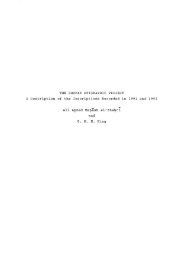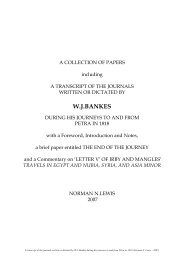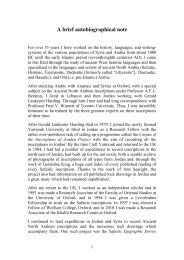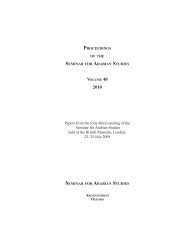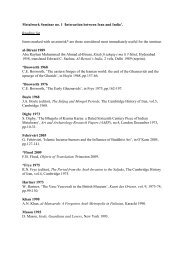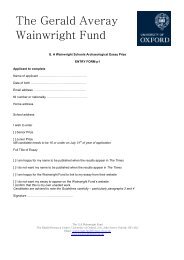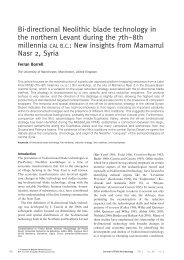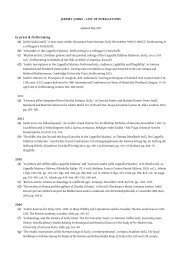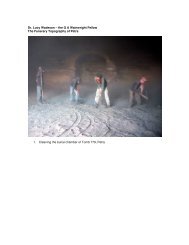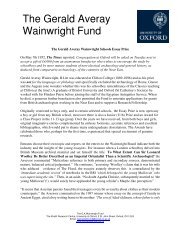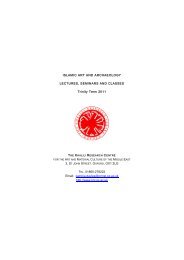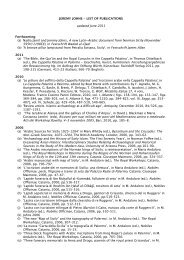W. J. Bankes and the Identification of the Nabataean Script - Khalili ...
W. J. Bankes and the Identification of the Nabataean Script - Khalili ...
W. J. Bankes and the Identification of the Nabataean Script - Khalili ...
Create successful ePaper yourself
Turn your PDF publications into a flip-book with our unique Google optimized e-Paper software.
78 N.N. LEWIS <strong>and</strong> M.C.A. MACDONALD<br />
Syria 80 (2003)<br />
<strong>Bankes</strong> had with him notes <strong>of</strong> Burckhardt's itinerary <strong>of</strong> 1812: southward through Trans-Jordan to Karak <strong>and</strong><br />
<strong>the</strong>nce to Wadi Musa <strong>and</strong> Petra. <strong>Bankes</strong> thought that it might be possible to follow <strong>the</strong> same track to Petra <strong>and</strong><br />
<strong>the</strong>n return to Karak, go round <strong>the</strong> sou<strong>the</strong>rn end <strong>of</strong> <strong>the</strong> Dead Sea <strong>and</strong> finally travel to Jerusalem via Hebron. With<br />
Irby <strong>and</strong> Mangles, he made what seems to have been an inadequately planned <strong>and</strong> badly executed attempt to do<br />
this in March 1818. They started from Jerash but got no fur<strong>the</strong>r than Salt, where, having fallen out with <strong>the</strong> Bani<br />
Sakhr Bedouin, whom <strong>Bankes</strong> had paid to conduct <strong>the</strong>m to Karak, <strong>the</strong>y ab<strong>and</strong>oned <strong>the</strong> attempt <strong>and</strong> retreated to<br />
Jerusalem.205<br />
Once in Jerusalem <strong>the</strong>y decided to attempt <strong>the</strong> journey in <strong>the</strong> opposite direction <strong>and</strong> made serious preparations<br />
to do so. They were now joined by Thomas Legh, a veteran traveller, 206 <strong>and</strong> by <strong>Bankes</strong>' invaluable servant,<br />
Finati, whom <strong>Bankes</strong> had summoned from Egypt. After making fruitless efforts to obtain authorizations from<br />
Ottoman <strong>of</strong>ficials <strong>the</strong>y resolved to go ahead without <strong>of</strong>ficial backing, trusting in <strong>the</strong>ir <strong>and</strong><br />
negotiating with local sheikhs as <strong>the</strong>y went. 207<br />
In <strong>the</strong> event all went well. The party, including servants <strong>and</strong> guides, numbered eleven persons, well armed 208<br />
<strong>and</strong> carrying sufficient < small gold coins ... concealed in lea<strong>the</strong>rn belts round <strong>the</strong> waist next <strong>the</strong> body >> 209 to<br />
meet <strong>the</strong> anticipated expenses <strong>of</strong> <strong>the</strong> journey. They rode out <strong>of</strong> Jerusalem on <strong>the</strong> evening <strong>of</strong> 6th May, travelled<br />
through Hebron, rounded <strong>the</strong> sou<strong>the</strong>rn end <strong>of</strong> <strong>the</strong> Dead Sea <strong>and</strong> reached Karak with relatively little trouble.<br />
There, <strong>the</strong>y were fortunate enough to secure <strong>the</strong> guidance <strong>and</strong> (sometimes uncertain) support <strong>of</strong> YisufMagali,<br />
>. 210 It was as well that <strong>Bankes</strong> <strong>and</strong> his companions did not know that, six years earlier, this<br />
same Yisuf Magali had ill-treated Burckhardt shamefully, 21 for <strong>the</strong>y took to him as soon as <strong>the</strong>y met him <strong>and</strong><br />
entrusted <strong>the</strong>mselves to his care without hesitation. They discovered his faults as time went on, but his behaviour<br />
towards <strong>the</strong>m was not overly bad <strong>and</strong>, as Irby <strong>and</strong> Mangles said, it is doubtful if <strong>the</strong>y would have reached Petra<br />
safely without him. 212<br />
Magali rode with <strong>the</strong>m to Shawbak <strong>and</strong> to <strong>the</strong> camp <strong>of</strong> Muhammad Abu Rashid (or Ibn Rashid 213 <strong>the</strong> forceful<br />
young sheikh <strong>of</strong> a section <strong>of</strong> <strong>the</strong> Huwatat, <strong>the</strong> dominant Bedouin tribe <strong>of</strong> <strong>the</strong> area south <strong>and</strong> east <strong>of</strong> Shawbak).<br />
The latter readily agreed to take <strong>the</strong>m to Wadi Musa. Unfortunately, Abii Zaytfn, <strong>the</strong> sheikh <strong>of</strong> Wadi Musa, who<br />
205. The only detailed account <strong>of</strong> this journey is given in IRBY & MANGLES 1823: 309-329.<br />
206. For Legh's previousjoumeys see LEGH 1816 <strong>and</strong> MACMICHAEL 1819. Legh had accompanied MacMichael on hisjourney from<br />
Moscow to Constantinople, after which he went on to Jerusalem where he met <strong>Bankes</strong>. Chapter Four <strong>of</strong> MacMichael's book is an account<br />
<strong>of</strong> <strong>the</strong> Petra journey written in <strong>the</strong> first person as if by Legh; in fact, however, it was < composed >> by MacMichael on <strong>the</strong> basis <strong>of</strong> what<br />
Legh had told him (MACMICHAEL 1819: 184).<br />
207. The period in Jerusalem is described by IRBY & MANGLES (1823: 329-339), by FINATI (1830, II: 224-234), <strong>and</strong> by Legh (in<br />
MACMICHAEL 1819: 188-194).<br />
208. IRBY & MANGLES (1823: 339) list .<br />
209. ibid.<br />
210. Journal, II: 71, cf. IRBY & MANGLES 1823: 460.<br />
211. BURCKHARDT 1822: 378-408.<br />
212. IRBY & MANGLES 1823: 475.<br />
213. Abu Rashid was <strong>the</strong> name <strong>of</strong> <strong>the</strong> section <strong>of</strong> <strong>the</strong> Huwaytat <strong>of</strong> which Muhammad was <strong>the</strong> shaykh (VON OPPENHEIM 1939-1968,<br />
II: 306, n. 7). Some <strong>of</strong> <strong>the</strong> travellers who met him called him < Ibn Rashid >> <strong>and</strong> o<strong>the</strong>rs >. BURCKHARDT (1822: 417) gave<br />
<strong>the</strong> name in Arabic <strong>and</strong> transliterated it as > while Legh (in MACMICHAEL 1819: 218f.) called him < Ebn Raschid >>. On<br />
<strong>the</strong> o<strong>the</strong>r h<strong>and</strong>, IRBY & MANGLES (1823: 382f.), FINATI (1830, II: 255f.), LINANT (in his log book, p. 16f., <strong>and</strong> see LABORDE & LINANT<br />
DE BELLEFONDS 1994: 123-124), <strong>and</strong> LORD LINDSAY (1838-1839, II: 40), all called him < Abou Raschid >, as did LABORDE (1830: 35,<br />
46; 1836: 97f.) before renaming him < A(c)kmed-Raschid >, for reasons which are obscure (1830: 51 <strong>and</strong> <strong>the</strong>reafter; 1836: 123 <strong>and</strong><br />
<strong>the</strong>reafter). ROBINSON & SMITH (1841, II: 553f.), who call him < Abu Rashid >> also gave <strong>the</strong> name in Arabic (III: 199) <strong>and</strong> stated that<br />
Burckhardt <strong>and</strong> Legh were incorrect in calling him < Ibn Rashid >> (II: 554, n. 1). A century or so later, VON OPPENHEIM (1939-1968, II:<br />
306, n. 7) reverted to >.. BURCKHARDT (1822: 417) described Ibn Rashid as <strong>the</strong> > <strong>of</strong> <strong>the</strong> Huwaytat. It is<br />
unlikely that o<strong>the</strong>r shaykhs <strong>of</strong> this large, scattered <strong>and</strong> very divided tribe would have allowed him such a title, but he was certainly <strong>the</strong><br />
head <strong>of</strong> a tribal section which was <strong>the</strong>n <strong>of</strong> considerable importance. In 1812, he led a large contingent <strong>of</strong> tribesmen <strong>and</strong> <strong>the</strong>ir camels to<br />
Egypt to transport some <strong>of</strong> Muhammad 'All's troops to 'Aqaba <strong>and</strong> Yanbo (BURCKHARDT 1822: 417). He was widely admired (see IRBY<br />
& MANGLES 1823: 383; FINATI 1830, II: 247-248; LABORDE 1830: 46; 1836: 97). His section was later, if not already, called <strong>the</strong> «<br />
Rashayidah > after him or his family. The Rashayidah evidently lost much <strong>of</strong> <strong>the</strong>ir prestige during <strong>the</strong> nineteenth century; <strong>the</strong>y are listed<br />
only as a subtribe <strong>and</strong> given no prominence in von Oppenheim's study <strong>of</strong> <strong>the</strong> Huwaytat tribes at <strong>the</strong> end <strong>of</strong> <strong>the</strong> nineteenth <strong>and</strong> beginning<br />
<strong>of</strong> <strong>the</strong> twentieth centuries (1939-1968, II: 285, 300, 306).



